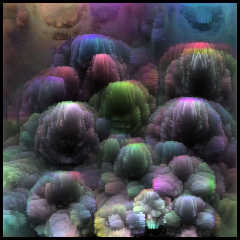|
 |
Hi,
I'm always trying to speed up cellular automata simulations, and to that
end have recently been investigating GLSL hardware shaders. My first
experience with using shaders was a few month back when I came across
Milkdrop for Winamp, which lets you write shader code for
visualizations, among other things. It was very deficient in many
regards, and in the name of Maximum Speed and Idiot Proofing, provided
only very limited functionality and a lot of grief.
Just when I thought I was going to have to code everything in C,
Processing showed up in the scope. I learned there was an OpenGL library
for it called GLGraphics which supports GLSL operations. Combined with
Processing's easy-going language and core graphics functions, GLGraphics
has made certain things a lot easier, not to mention /faster/.
The attached render uses 16-bit data from a CA rule I discovered a while
back, but am now able to render quickly (roughly 55 fps @ 1024x1024).
Height values with 16-bit precision were used to make a height_field,
and a regular color image was used for its pigment.
The translucent effect is an old trick involving two objects:
* Object 1 has a pigment, diffuse reflection, zero brilliance,
no_shadow, and is double_illuminating.
* Object 2 is slightly offset from object 2. It is transparent,
hollow, and has absorbing media.
Well anyway, Processing and GLGraphics can obviously be used for more
than CA. Check it out, it's pretty cool.
http://www.processing.org/
http://codeanticode.wordpress.com/2010/08/22/glgraphics-0-9-4/
Sam
Post a reply to this message
Attachments:
Download 'catestb12_01.jpg' (126 KB)
Preview of image 'catestb12_01.jpg'

|
 |




![]()